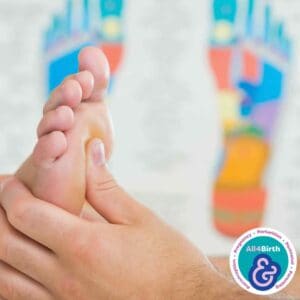Abbie Tomson
Midwife MSc, BSc, Yoga Teacher, Project Lead at All4Birth
@enevlorel
Summary
Childbirth is a profound experience marked by a range of sensations, including the discomfort of labour contractions. While medical interventions like epidurals offer effective pain relief for some, others seek alternative methods to manage labour pain. Transcutaneous Electrical Nerve Stimulation (TENs) machines have emerged as a popular choice, offering a drug-free and non-invasive approach to pain relief during labor. This blog post delves into what a TEN machine is, the evidence supporting its use in labour, and practical considerations for expectant parents.
Please do not use TENS if you have a cardiac pacemaker.
DO NOT use TENS in water
What is a TENs Machine?
A TENs machine is a small, portable device that delivers mild electrical impulses through electrodes placed on the skin. These impulses stimulate the nerves, blocking pain signals from reaching the brain and triggering the release of endorphins, the body’s natural pain-relieving hormones. In the context of labour, TENs machines are typically used to alleviate the discomfort of contractions and provide relief during the early stages of labour. When using TENS during labour, you may feel a buzzing, tingling, or prickling sensation wherever the pads are placed. It’s easy to administer, and the person who is receiving the TENS can control the intensity of the sensation using the buttons on the device. TENS can be used in combination with other non-drug and drug methods of pain relief – except with water. It’s also not supposed to be used together with heat.
There are various models available, some hospital trusts or local children’s centres may offer the ability to ‘rent’ out a unit or alternatively, you could purchase your own. Some on the market offer a ‘boost’ button which enable you to have a stronger impulse during a contraction.
How do TENs Machines Work?
Transcutaneous Electrical Nerve Stimulation (TENS) is a non-invasive method used to control pain. It involves the use of a battery-powered device that delivers electrical impulses through electrodes attached to the skin. The primary theories explaining the mechanisms through which TENS alleviates pain include the Gate Control Theory and the release of endogenous opioids.
1. Gate Control Theory: Initially proposed by Melzack and Wall in 1965, the Gate Control Theory suggests that the perception of pain is not a direct result of the activation of pain fibres but is modulated by the interplay of different neurons in the spinal cord 1. According to this theory, the electrical impulses generated by the TENS unit can activate non-nociceptive (non-painful) nerves that send signals faster to the brain than the pain signals being transmitted by slower, smaller fibres. This process effectively “closes the gate” to painful input, which prevents pain signals from reaching the brain, thus reducing the sensation of pain.
2. Endogenous Opioid Release: Another theory suggests that TENS works by stimulating the release of endogenous opioids within the central nervous system 2. These natural chemicals, such as endorphins, act like morphine by binding to opioid receptors in the brain to reduce pain perception. Studies have shown that the activation of opioid receptors in the spinal cord and brain can significantly inhibit pain, and this mechanism is enhanced through the application of TENS at certain frequencies (usually low-frequency TENS).
3. Segmental Inhibition: TENS may also reduce pain through segmental inhibition mechanisms. By stimulating the sensory nerves that innervate the same spinal segments where pain signals are transmitted, TENS may inhibit pain transmission at the spinal level, effectively reducing the sensation of pain 3.
4. Central Inhibitory Effects: There is also evidence suggesting that TENS may exert its effects through central mechanisms involving the descending pain inhibitory pathways. By stimulating these pathways, TENS can modulate pain at the brain level, further contributing to its pain-relieving effects 3.
Evidence on the Use of TENs in Labour
Numerous studies have explored the effectiveness of TENs machines in managing labour pain, with mixed results, here we have selected two and linked more in the resources:
A Cochrane review 4
This systematic review evaluated the effectiveness of TENS machines for labour pain by analysing data from 17 randomised controlled trials involving approximately 1,500 participants. The studies varied in their control groups, which included routine care, placebo TENS (either turned off or set to very low intensity), and comparisons to other non-drug pain relief methods.
Key Findings:
– Most of the placebo-controlled trials involved a TENS unit that was not activated or was on a very low setting, which may have led to some participants realising they were receiving a placebo.
– Overall, there was minimal difference in pain ratings between participants using active TENS and those in the control groups. However, participants using TENS on acupuncture points reported less severe pain.
– A notable number of participants expressed a preference for using TENS in future labours, including those in the placebo group, suggesting a psychological benefit from just having the unit applied.
– In trials where TENS was used alongside an epidural, there was no additional benefit in pain reduction.
– The studies reported no serious adverse effects, except for minor skin irritation under the electrode pads and one instance where TENS interfered with electronic fetal monitoring.
This review suggests that while TENS may offer limited direct pain relief in labour, its application might provide psychological comfort and a sense of control to some women. The device was generally safe to use, with minimal risk of side effects.
More recent research:
The study compared the effectiveness of Transcutaneous Electrical Nerve Stimulation (TENS) versus a combination of pethidine and promethazine injections for reducing pain during labour 5. 90 pregnant women in active labour were divided into two groups: one group received TENS therapy, and the other received injections of pethidine and promethazine. TENS was applied using electrodes on the arms and lower back for 120 minutes. The medication group received an initial dose of 100 milligrams of pethidine and 250 micrograms of promethazine, with the option of a second dose at least one hour later.
Key Findings:
– Pain Reduction: Initially, both groups had similar pain levels (VAS scores around 8.4). After interventions, pain scores reduced to 6.29 in the TENS group and 5.73 in the medication group, indicating pain relief in both groups without significant difference between them.
– Labor Duration: The duration of labour was approximately 6.61 hours in the TENS group and 6.17 hours in the medication group, with no significant differences.
– Safety: No complications were reported in either the mothers or the newborns in both groups.
TENS is a viable option for managing labour pain. It effectively reduced pain scores by at least two points and demonstrated a safety profile comparable to standard pain management with pethidine and promethazine, without any significant complications. This summary highlights that TENS could be considered a safe and effective alternative to traditional medication for pain relief during labour.
Practical Considerations and Tips for Using a TENs Machine in Labour
- Early Application: Use the TENs machine at the onset of labour or when contractions become regular to maximise effectiveness.
- Proper Placement: Ensure electrodes are positioned correctly on the lower back or abdomen, as directed by the device’s instructions. Sat upright, have an imaginary line from the navel to the centre of the spine. Position the top two pads approximately 4cm on either side of the spine and 4-5cm above the imaginary navel line. Position the bottom two pads approximately 4cm on either side of the spine and 4-5cm below the imaginary navel line (over the sacral dimple area).
- Adjust Settings: Experiment with different intensity levels and pulse frequencies to find settings that provide optimal pain relief without discomfort.
- Partner Support: Enlist the help of a birth partner or support person to assist with applying and adjusting the TENs machine during labour.
- Compatibility with Other Pain Relief Methods: Consider how a TENs machine can complement other pain management techniques, such as relaxation, breathing exercises, and movement.
Conclusion
TENs machines offer a natural, drug-free option for managing labour pain, providing expectant parents with greater control and flexibility during childbirth. While evidence of their effectiveness is mixed, many individuals find relief and comfort from using a TEN machine during the early stages of labour. As with any pain management technique, it is essential to discuss the use of a TENs machine with your healthcare provider and incorporate it into your birth plan based on your individual preferences and needs. By exploring alternative methods like TENs machines, expectant parents can navigate labour with confidence, comfort, and empowerment.
Links to other resources
 Websites, Guidelines and Journal Articles
Websites, Guidelines and Journal Articles
Santana, L. S., Gallo, R. B. S., Ferreira, C. H. J., et al. (2016). Transcutaneous electrical nerve stimulation (TENS) reduces pain and postpones the need for pharmacological analgesia during labour: a randomised trial. Journal of Physiotherapy, 62, 29–34.
Shaban, M. M. (2013). Labour pain relief using transcutaneous electrical nerve stimulation, maternal and fetal impacts: A randomized-controlled study. Evidence-Based Women’s Health Journal, 3, 178–182.
Shahoei, R., Shahghebi, S., Rezaei, M., et al. (2017). The effect of transcutaneous electrical nerve stimulation on the severity of labour pain among nulliparous women: A clinical trial. Complementary Therapies in Clinical Practice, 28, 176-180.
NICE Clinical Guidelines, No. 190. (2014). Intrapartum care for healthy women and babies. National Institute for Health and Care Excellence.
National Health Service (2022) ‘TENS (transcutaneous electrical nerve stimulation)’ Available at:
References
1. Melzack, R., & Wall, P. D. (1965). Pain mechanisms: A new theory. *Science, 150*(3699), 971-979
2. Han, J. S. (2004). Acupuncture and endorphins. *Neuroscience Letters, 361*(1-3), 258-261.
3. Vance, C. G. T., Dailey, D. L., Rakel, B. A., & Sluka, K. A. (2014). Using TENS for pain control: The state of the evidence. *Pain Management, 4*(3), 197-209.
4. Dowswell, T., Bedwell, C., Lavender, T., & et al. (2011). Transcutaneous electrical nerve stimulation (TENS) for pain management in labour. Cochrane Database of Systematic Reviews, (9), CD007214.
5. Saedi, N., Shokouhi, N., Feizabad, E., Moghimi, Z., & Mohseni, M. (2023). The transcutaneous electrical nerve stimulation with the injection of pethidine and promethazine in the labour pain reduction: A randomized controlled trial. Caspian journal of internal medicine, 14(4), 628–632. https://doi.org/10.22088/cjim.14.4.62










